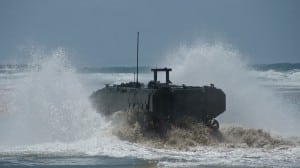
The Marine Corps has completed additional cost studies on its Amphibious Combat Vehicle (ACV) program and slightly raised its cost estimate to about $5 million per vehicle. Lt. Gen. Kenneth Glueck, deputy commandant for combat development and integration, said Thursday at a Defense Writers Group breakfast in Washington that the four contractors under consideration estimated a cost a bit lower than $5 million, but when the Marine Corps factors in other programmatic costs–particularly extra vehicles needed for testing and spares–he…













